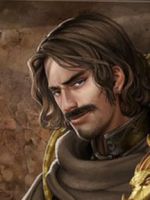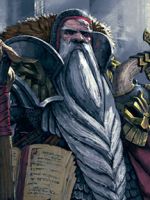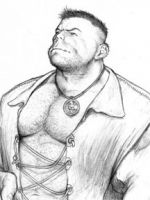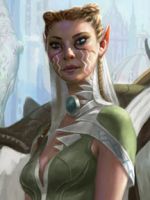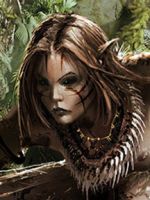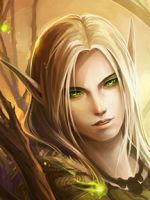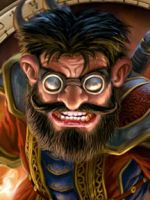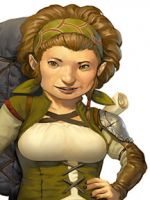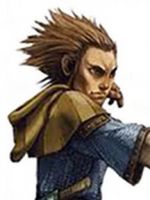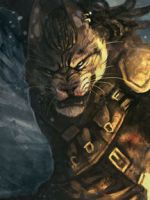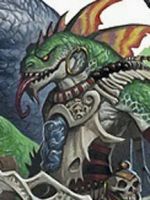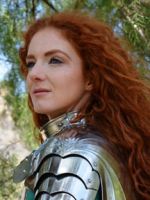|
Threxen
The Threxen people are the most populous of the human bloodlines in Threxantra. They are descended from the ancient Carlitia, Thissia and Thexdoni people, once separated by oceans before their lands had been merged together through arcane means to form what is now Threxantra.
Threxen people can stand from 5' to a little over 6' tall and weigh from 125 to 250 pounds. Skin shades range from olive to pale and hair color from black to blond (curly, kinky, or straight). Threxen garb and grooming varies by region. Daltes men wear kilts and trousers with tunics and flat caps and bonnets and prefer groomed beards or mustaches and short hair and women grow their hair long and wear long skirts and sashes, often leaving one breast bared. In Talaria men generally wear pants, coats and hats with wide brims and/or tall crowns, have shoulder length hair and shave or have sculpted mustaches and goatees. The women wear long dresses that offer more modesty than their Daltes neighbors. In Estland, fashion changes often and holds a much more important role in their society, especially amongst the nobility, but the more rich, intricate and extravagant their appearance and garb is, the more impressive they are viewed by their peers. In other regions of Threxantra, humans live near or amongst other races. The Threxen of Nakaltia live amongst dwarves and gnomes, the Threxen in Salista Hoventesh that are not slaves to the orcs, live amongst the hoven in cities such as Ma-Kare, Stranded (until they were all recently turned into tieflings) or Gold Chip.
- Religion: The vast majority of Threxen follow the tenants and beliefs of the Church of Dom. They build grand temples and openly revere the gods of the Pillar of the Illuminated and maintain temples or shrines of varying scale and publicity for the gods of the Pillars of the Mysteries and the Veiled. Some of those living in less human dominated regions choose to worship other deities. In Nakaltia there are Threxen who trace their ancestry directly to their Carlitia ancestors and worship the Olympian gods of their ancestors.
- Traits & Adjustments: See entry for Human in the Players Handbook. You may choose to either use the standard Ability Score Increase or the Variant Human Trait.
- Languages: You can speak, read, and write Threxantran and one extra language of your choice.
Threxen speak the Threxantran language. They typically learn the languages of other peoples they deal with as well, including obscure ones. Threxen are fond of sprinkling their speech with words borrowed from other tongues: dwarven curses, elvish musical expression, ogre military phrases, and so on.
|
|
Vaalar (Mountain Dwarf)
The vaalar are the mountain dwarves of Nakaltia as well as the distant Osar of mountains in Gannir. They believe that they are descendants of the ancient goltiri, the first dwarves created by the Primordials. The goltiri had delved deeper and deeper into the world and vanished. The dwarven pantheon of gods had been the first born of their kind, granted immortality and divinity by their creators so that they could serve as eternal guardians and guides to their people.
The Nakaltian vaalar once lived in fantastic underground cities beneath the mountain ranges of old Carlton. The most famous of all dwarven cities is Gol Dragga, which spans the width of two mountains. The vaalar traditionally had little interest in the affairs of other races, most having never even seen a non-dwarf. They had always been largely disinterested in involvement with others unless they were convinced that the matter affected them directly.
The vaalar were known to be stubborn and gruff and put a great deal of stock into tradition and the prestige and social-political pageantry of wealth, hierarchy, rank and pedigree.
The vaalar mined and crafted wonders of iron, silver, gold, gems and other precious metals and stone, but chief amongst them was mithril.
They were ruled by an ancient monarchy with a lineage traced all the way back to the goltiri and the gods themselves. Their nation was the sworn enemy of the drow of Hesvillax. It was after the century long Golem War that the duergar, or grey dwarves, were exiled into Underdark (where they would later be enslaved by the illithid). The aftermath of the war and the duergar exile resulted in a civil war and the division of the royal family.
In the event that would later be known as the Wrath, the continent of Carlton was catastrophically dragged across the sea to crash into the western coast of old Threxantra. This unnatural geological disaster devastated the vaalar realm. Most of the subterranean world was destroyed entirely and the survivors were forced to abandon most of the cities carved into the mountain interiors that did not immediately perish.
With the royal bloodline seemingly lost, the vaalar military took control.
Their new leadership found themselves surrounded by chaos on the surface, and took it upon themselves to fix it.
The vaalar armies quickly established order amongst their surviving people and then they turned to others in need. Quickly and efficiently, the dwarves conquered or united most of what was once central Carlton. They would later ally with Valexys to their south and Zalcoryn to their north, which acted as a buffer between them and the aggressive minotaur tribes beyond.
A new monarchy was established, though the military still maintained a great deal of power, and most people consider the monarchy little more than a token recognition of old tradition with little true power.
The dwarves have since built new homes beneath the mountains, though many choose to live on or near the surface and interact with other races.
Since they emerged from the depths, the dwarves have been waging an ongoing war against organized legions of hobgoblins that claim the land was their own and would see the order they had established undone.
Steam engines and other technologies have been developed by vaalar engineers and several of their settlements are now connected by powerful steam engine powered trains that move along tracks. Their technological cunning has only been enhanced by the recent influx of gnomes that had been welcomed into Nakaltia when they fled the destruction of Northoll.
The dwarves lost a great deal of their heritage and history during the Wrath. Successful efforts to reclaim relics and pieces of this history hold a great deal of prestige amongst them. Recently the vaalar have uncovered passages into the ruins of their once greatest of cities, Gol Dragga, and numerous explorers, scholars and adventurers have jumped at the chance to delve into the bones of the ancient mountains to see what they can bring back out.
The vaalar stand between 4'3" and 4'9" in height, but are so broad and compact that they can weigh as much as a human standing nearly two feet taller. Vaalar are typically pale with blue, hazel or brown eyes. Their hair ranges equally from dark hues to blond and red. Both male and female vaalar grow thick facial hair that is often used to display social status (unlike the female tolar that shave).
The vaalar are a long lived race, and reach physical maturity somewhat later than humans. A dwarf is traditionally considered an adult once he or she reaches age fifty. Dwarves age much like humans but over a longer period of time, with an average lifespan of 350 years.
- Religion: The dwarves of Nakaltia worship the gods of the ancient dwarven pantheon, whom they consider to be their ancestors. They also highly revere and respect Reorx, Brell Serilis and the others gods of earth and artifice. Nakaltia respect the beliefs of others and do not interfere with missionaries from the Dom Church, but most have little tolerance for anyone trying to tell them what to believe in and are likely to pummel anyone who dares insult their gods and ancestors.
- Traits & Adjustments: See entry for Dwarf and Mountain Dwarf in the Players Handbook.
- Languages: You can speak, read, and write Goltiri and one extra language of your choice.
The dwarves speak the ancient language of the Goltiri, their ancestors that were wrought from the stone and metal of the primordial realm at the dawn of creation.
|
|
Hoventi (Half-Orc)
The Hoventi or more commonly just "hoven" are the half-orcs of Salista Hoventesh & Krive Del, though the term has come to be used for all half-orcs, which have become relatively common in many parts of Manix.
In the past most of the hoven had lived amongst other orcs, spawned from their unions with human slaves and captives. These half-orcs were seen as humans, and were thus born into slavery to their orc masters. Those who fled lives of slavery amongst the orcs were forced to live amongst other races, usually humans. Whether proving themselves among rough barbarian tribes or scrabbling to survive in the slums of larger cities, the hoven would get by on their physical might, endurance and sheer determination inherited from their human ancestry.
Generations down the line, the hoven population swelled in Salista Hoventesh until they came to rival the numbers of their orcish masters. There were a number of slave rebellions amongst some of the clans, and the slaves that had won their freedom flocked to the free city of Ma-Kare, where they found equality in a new home for themselves behind its massive walls with a myriad of other races.
These free hoven became a symbol of hope, inspiring other slaves amongst the clans to rise up against their orc masters. It was during this chaos, that the "Emperor of Salista Hoventesh" had risen and started uniting orc clans in order to stand against the growing threat of Krive-Del. He also saw the growing danger of the hoven slaves and turned it to his benefit by outlawing hoven slavery, freeing all the hoven of the clans - they were given a choice, join the clan and fight, like all true orcs, or they could choose to seek their freedom in exile and leave Salista Hoventesh. Most chose to join the clans they had grown up with, savoring the glory of blood and battle as any true orc would. Others chose to leave, though most fled into the eastern forests or to Ma-Kare, while both were still in Salista Hoventesh, they were considered safely beyond the Emperor's reach.
- Religion: As most of the hoven live in Salista Hoventesh and the surrounding regions, they tend to worship the gods and spirits of those regions. Some choose to worship the ancient gods of the orcs, others are drawn to the gods of the Dominion Church, and many others choose to honor other powerful spirits or planar entities.
- Traits & Adjustments: See entry for Half-Orc in the Players Handbook.
- Languages: You can speak, read, and write Orbaan or Threxantran and one extra language of your choice.
|
|
Misanti (High Elf)
‘’’Side Note:’’’ A quick note about elves. There are three tribes of elves in the world, each claiming to be the “true” elves, first created, bla, bla, bla - and consider the other two to be lesser cousins, if elves at all. The three tribes are the Ilfyd, the Ydis and the Syi.
The misanti, often called "high elves" by outsiders, are divided into three separate tribes that live in the forested elven homeland of Mistanta: Rhesari, Isani and Felelari (each of which is described further down).
The Misanti are a fairly conservative warrior-aristocracy society with a greater understanding of magic than most and a highly developed mystical tradition.
The abstract Misanti psyche is both mystical and logical – creating a nearly perfect balance between the two. They have a strong influence of seeing the duality of things, and do not limit themselves to the one-sided view of things, always, allowing them to see much beyond the extent of most humans, who tend to be the antithesis of this. They have a male and a female ruler, and the very characters in their language cannot mean one single thing, but represent many.
Misanti are seen as emotional creatures, perceived by some as empathetic, as well as passionate about things in which they take liking to. However, despite this trait, they can also be rash when angered, and many have a temper about them, with a great dislike to being wrong. They are extremely focused beings, and it is said that misanti may look at a painting for what seems to have been a single moment, and become so intrigued in every little detail of it, that they will lose track of time and a year will have passed by when they finish. Even such interesting topics could take a thousand years to fully contemplate. With their long life spans, time in comparison to that of human, is less important. Misanti also have a great love of intrigue – they are a political race, and do enjoy the aspects of this quality to the fullest.
Three factors separate the three Misanti tribes: geography, appearance and their view on magic.
The Misanti as a whole are highly adept at magic, it enhances their everyday lives.
Though it is not perceived to be a highly dependent source of obtaining something, it will be used to improve the quality of something. For example, magic will be used to strengthen the toughness of a building, and protecting it with charms, as seen with many of the structures in ancient Rhesaris.
The major split in philosophy between the three tribes on magic is how it relates to convenience.
The Rhesari will frequently use magic to fulfill the tedious tasks of life, such as cleaning a room or sending a message, which allows them more time to focus on things they consider to be more important. Where the Isani believe that to be a disservice to oneself and believe that if something is worth doing, it is worth doing yourself - magic may be used as a shortcut, but not as a means to circumvent the act entirely. The Ferelari on the other hand believe that magic should not be used for whimsy or convenience, but they also do not believe in handling things directly themselves - this is where they have long relied on slaves.
So where the Rhesari use magic to clean their chamber pots, the Isani do it themselves and the Ferelari have slaves clean them.
- ’’’Rhesari’’’ - The Rhesari feel it is their calling to uphold every ancient elven tradition and enforce elven law. They are the source of the lovely, aloof and haughty magical elf stereotype that would rather levitate something they drop than bend over to pick it up that most of the world believes in.
The average Rhesari elf stands five feet tall and weighs approximately ninety to a hundred pounds. They are a fair-skinned race, with hair color ranging from light brown to white blonde, lack any other facial or body hair, and have brilliant blue, green or hazel eyes. The Rhesari possess an almost supernatural beauty and are considered the most graceful and lovely of the elves. Rhesari are fond of flowing garments made from delicate materials and jewelry made from pale metals gems, especially diamonds, amethyst, sapphires and moonstone.
- ’’’Isani’’’ - The Isani are the most outwardly friendly of the Misanti elves, having more recently seceded their territory from Misanta and formed their own nation in order to have greater freedom to pursue relationships with the races of the other continents. The Isani believe in hard work and have a very hands on attitude towards most things.
The average Isani elf stands just less than five feet tall with a slender build. The Isani have tanned skin and hair ranging from honey-brown to blond in color and lack facial and body hair. Their eyes are either blue or brown. The Isani usually prefer to dress themselves in clothes of earthen hues, and their clothes are normally fashionable as well as functional. While still considered to be far fairer than even the loveliest of humans, the Isani lack the surreal grace and beauty that is the mark of their Rhesari cousins.
- ‘’’Ferelari’’’ - The practical and military minded Ferelari live within the southern forests of Misanta. The Ferelari have long practiced human slavery, believing that humans and other lesser races should serve them in taking care of mundane matters, such as annihilating unclean interlopers into their realm.
The Ferelari are called the dark mirror of the Rhesari, for each tribe is nearly identical, save that the Ferelari have raven black hair and eyes that are deep, dark blue, purple or red. Where their cousins prefer flowing lace and gossamer, the more Ferelari prefer tightly fitted garments that are crisp and functional. They do not wear jewelry for decoration as the Rhesari do, but wear emblems and signets of rank and station.
- Religion: Most of the Misanti worship Corellon Larethian and the other deities of the ancient elven pantheon.
- Traits & Adjustments: See entry for Elf and High Elf in the Players Handbook.
- Languages: You can speak, read, and write Misantil and one extra language of your choice.
|
|
Sethi (Wood Elf)
The sethi, often called wood or wild elves by others, dwell in the various forested realms across Manix, with their largest concentrations in Misanta and Katrica. The sethi are protective of their woodland territories, living in harmony with the land and beasts around them. Given a history of mistreatment by their misanti cousins, sidhe enslavement, being hunted by humans and having their trees cut down by anyone with a sharp object in the name of "progress", the sehti tend to be very cautious of outsiders. They are peerless hunters and silent and near invisible in the forest.
Most of the sethi live under a tribal system, where each tribe is centered on a chief and a circle of wisdoms or advisors. The tribes either live wild in the forest or sometimes in portable structures, with very few building permanent structures. Those who do construct buildings do so in a manner than compliments the natural world around them, either built upon and around natural features or constructed magically amidst nature. Several of the tribes in Katrica have tree shapers, mystics capable of singing and encouraging the natural grown of trees into shapes and forms that would otherwise be impossible - a massive tree can be grown over hundreds of years to include dwellings and passages within its body. It is said that the Kesiana of Katrica have a great lodge, capable of holding hundreds of elves, that was grown from many dozens of great vallen and immortal oak trees, all twining together to form a colossal living hall.
The sethi have a strong sense of history and ancestry which they relate through oral tradition and song, though many of these histories have been documented by scholarly visitors which they welcome, so long as they too share new tales with them in exchange and respect the natural world around them.
- Religion: The sethi have a very strong druidic tradition and many believe in powerful totemic spirits that they worship as divinity. A few amongst the sethi also worship the ancient elven pantheon.
- Traits & Adjustments: See entry for Elf and Wood Elf in the Players Handbook.
- Languages: You can speak, read, and write Misantil and one extra language of your choice.
|
|
Asana
Also known as star elves, the asana are claimed by neither the Ilfyd elves (misanta, sethi, etc) nor the Ydis elves (scindo & fei). They claim to be fae creatures, descended directly from the powerful sidhe of Faerie, but from generations of mixed breeding, now bare both elven and human ancestry - whatever the original asana race that they had descended from long ago is long lost. The asana have no homeland that they call their own and generally live amongst humans or other races that will have them. Historically the asana were closely associated with the chaotic and often violent hiklos and this stigma follows them to this day. The asana do not enter trance states when they rest like other elves, in fact they are renowned for their love of sleep and dreaming, often giving them a reputation of being lazy to other races.
The asana are of human height. They are slim, and even the strongest simply look athletic rather than musclebound. They have the same range of complexions as humans, though they are more often fair than dark. Their straight, fine hair is often white, silver, or pale gold, though many of them dye their hair in more exotic colors and they wear it long and loose. Their pointed ears are significantly longer than those of other elves and impossible to conceal in their hair. Their eyes are vibrant, almost luminescent and range anywhere in the spectrum. Because of their mixed bloodlines, some asana are capable of growing facial hair, where others are not. Those who can are often fond of growing mustaches or beards that are oiled and outlandishly styled.
- Religion: The asana worship whoever they wish. Some worship the elven gods, others worship the Dom Church, even more honor other powers. There is even a well-known asana priest in Nakaltia that is a prominant member of the dwarven priesthood.
- Traits & Adjustments:
- Increase your Dexterity score by 2 and your Intelligence score by 1.
- Darkvision 60'
- Keen Senses: You have proficiency in the Perception skill.
- Fey Ancestry: You have advantage on saving throws against being charmed.
- Cantrip: Choose either Thaumaturgy, Druidcraft or Prestidigitation. You know this cantrip and can use it at will.
- Lucky: When you roll a 1 on an attack roll, ability check, or saving throw, you can reroll the die and must use the new rolls.
- Languages: You can speak, read, and write any two languages of your choice.
|
|
Thriken (Rock Gnome)
Thriken gnomes can be found primarily in Nakaltia and Striker. The gnomes of Striker had long ago settled in Tranzconox, establishing a new nation and now live amidst humans, gnolls, kobolds and goblins. The gnomes in Nakaltia are relatively new to living amongst their dwarven allies. The ancient gnomish homeland of Northoll had been destroyed, sank beneath the waves by its own people in order to stop the advance of the Nycandrian army. By sacrificing their own homeland rather than give it up, dealing a devastating blow to the military might of Nycandria, halting their advance and forever taking away the tactical advantage that Northoll would have given them against the west, the gnomes became heroes.
Thriken are ambitious folk, whose lives are validated by a masterful command of the scientific laws of the universe and unbridled creativity. This outlook on life makes them feel that to be pitied is unbearable, even insulting, though they know their allies do not do this intentionally. They have always been of a race of inventors, artisans and scholars throughout their history, generally focused on escaping and avoiding conflict. Great value has always been placed on one’s ability to avoid trouble and stay out of the way of others. Children’s games often involve elements of stealth and amongst adults drawing attention to one’s self is considered a breach of etiquette. Legends of gnomish heroes are usually not of powerful warriors but of subtle tricksters, who sneak past or trick their opponents rather than vanquishing them in combat. This in part comes from the long-standing issues gnomes have faced, which is their miniscule size compared to larger predators or enemies. However, with the loss of the gnomish homeland of Northoll and years of hardship and increased association with the dwarves of Nakaltia or the harsh races of Tranzconox, many gnomes have become bolder. While gnomes continue to put high value on wit and intelligence, gnomish warriors and adventurers have become more common, and as a race they are more likely to talk back to Tall Folk than in the past.
Most Nakaltian gnomes live amongst the dwarves in sprawling cities that honeycomb mountains and the depths below. They have accepted the laws and authority of the region, which they become increasingly involved with.
Striker gnomes live perched atop neatly packed, tiered cities of stone and glass. Surprisingly, given their harsh surroundings, they live relatively comfortable lives with many conveniences, allowing many to focus on art and invention, though this is largely because gnomes are also the wealthy and ruling nobility in the nation. Striker survives through trade, importing and exporting goods from several neighboring regions. In addition to devices of gnomish ingenuity, they export glass, stone, stone and pottery vases, linen, papyrus, gold vessels and jewelry, ox hides, ropes, fragrances, lentils, and dried fish. Striker is ruled by a complex hierarchy of wealthy property and business owners and the Swiftstriker nobility. Their people consist primarily of humans and goblins with a mix of kobolds and gnolls as well, all of whom make up the lower and middle working classes.
Gnomes average slightly less than 3 feet tall and weigh 30 to 35 pounds. They have prodigious noses and bright eyes that seem to gleam with energy and enthusiasm. Striker gnomes have pale ruddy skin, where Nakaltian gnomes tend to have olive to swarthy skin. Their fair hair has a tendency to stick out in every direction, as if expressing the gnome's insatiable interest in everything around them.
A gnome's personality is writ large in his or her appearance. A male gnome's beard, in contrast to his wild hair, is kept carefully trimmed but often styled into curious forks or neat points. A gnome's clothing is elaborately decorated with embroidery, embossing, or gleaming jewels.
- Religion: The gnomes of Tranzconox worship and honor both the Dom pantheon as well as the gnomish pantheon. The Church continues in their attempts to purge this heretical aspect from their faith, but most gnomes who enter the priesthood already have a deeply rooted faith and love for the old gnomish gods. As a result the Church has started sending more priests, preferably gnomish priests, to the nation of Striker and surrounding regions in order to better educate the natives of their unwholesome obsession with these dangerous old pagan gods. The gnomes of Nakaltia primarily worship the gnomish pantheon, though they are respectful to other faiths and their gods, specifically those aligned in the interests of their own, but they will not tolerate Dominion priests that attempt to dictate who and how they worship.
- Traits & Adjustments: See entry for Gnome and Rock Gnome in the Players Handbook.
- Languages: You can speak, read and write Nokol and one extra language of your choice. Gnomes of Nakaltia can choose to substitute Goltiri in place of Nokol.
Nokol is the native gnomish language, though since the destruction of the gnomish homeland of Northoll, use of the language is in decline as an increasing number of the gnomes that fled to Nakaltia have converted to the use of Goltiri. Nokol is still commonly spoken amongst the gnomes of Striker in Tranzconox, though most of them are also fluent in Conox, which is the dominant language spoken by most of their non-gnomish constituents and neighbors.
|
|
Hobbit (Stout Halfling)
The comforts of home are the goals of most hobbits’ lives: a place to settle in peace and quiet, far from marauding monsters and clashing armies; a blazing fire and a generous meal; fine drink and fine conversation.
There are very few hobbits in Manix, tucked away in the southern corner of Valexys, they are the remnants of a terrible purge inflicted upon their race by the mad Archmage Katrina many generations ago.
The diminutive hobbits survive in a world full of larger creatures by avoiding notice or, barring that, avoiding offense. Standing about 3 feet tall, they appear relatively harmless and so have managed to survive for centuries in the shadow of empires and on the edges of wars and political strife. They are inclined to be stout, weighing between 40 and 45 pounds.
Halflings’ skin ranges from tan to pale with a ruddy cast, and their hair is usually brown or sandy brown and wavy. They have brown or hazel eyes. Halfling men often sport long sideburns, but beards are rare among them and mustaches even more so. They like to wear simple, comfortable, and practical clothes, favoring bright colors.
Halfling practicality extends beyond their clothing. They’re concerned with basic needs and simple pleasures and have little use for ostentation. Even the wealthiest of hobbits keep their treasures locked in a cellar rather than on display for all to see. They have a knack for finding the most straightforward solution to a problem, and have little patience for dithering.
In more recent times, some of their number, mostly young impressionable hobbits, had been lured away by a hobbit claiming to be from another world, who led them to the ruined city of Malixia far to the northeast of Valexys and laid claim to it as their own. Led by this "King Gerrin", these hobbits train as warriors and bandits, preying upon the communities around them.
- Religion: Words go here.
- Traits & Adjustments: See entry for Halfling and Stout in the Players Handbook.
- Languages: You can speak, read, and write either Laeo or Threxantran and one extra language of your choice (which may be the other one if chosen).
|
|
Ilian (Lightfoot Halfling)
The ilian of Valexys are descendants of a race called the kender from another world that became stranded when their strange magical ship crash landed in Valexys. Initially mistaken as some sort of hobbits, neighbors were quick to shun them in fear of becoming associated with the doomed species and drawing the attention of the mad Archmage Katrina who had nearly eradicated the hobbit race from the land as well as any others that had provided them succor.
The stranded little folk established a new home and eventually a new culture and identity for themselves, as their old ways were not conducive to the self-sufficiency necessary to survive as a species. They modeled themselves after the hobbits of the old world, having inherited those lands as their own and they called themselves the ilian, a Laeo word meaning to be reborn (though technically it translates literally to "twice-baked" in reference to a baking method).
While many of the ilian have settled down and are content to live out their days in remote agricultural communities, others form nomadic bands that travel constantly, lured by the open road and the wide horizon to discover the wonders of new lands and peoples. But even these wanderers love peace, food, hearth, and home, though home might be a wagon jostling along an dirt road or a raft floating downriver.
The ilian stand a few inches over three feet tall and usually weigh between 30 and 35 pounds. They have ruddy skin, blond, brown or black hair, with red being a rarity and bright hazel, blue or green eyes. Ilian men often grow long sideburns, but beards are rare among them and mustaches almost unseen. They like to wear simple, comfortable, and practical clothes.
- Religion: Most of the ilian worship Yondalla and the other gods of the hobbit pantheon.
- Traits & Adjustments: See entry for Halfling and Lightfoot in the Players Handbook.
- Languages: You can speak, read, and write Laeo and one extra language of your choice.
|
|
Cathian
Cathians are an anthropomorphic species of humanoids that had been created through the Archmage Katrina Moonsinger's magical experiments on captives (mostly hobbits and humans) in her "Genesis Chamber" deep below the Azure Academy of Katrica. Following their creation she released them into the world and having lost interest in the project ignored them.
The cathian struggled to find their place in the world. The memories of the first cathian, who had all been people with lives and histories, had been erased, so they had nowhere to go. They lived in the forests of Katrica for a time, though neither the Katrican nationalists, nor the elves or fae of the forest accepted them - seeing them instead as monsters. It wasn't until two of their kind had risen to fame that they had started to find some sort of acceptance in the world; the Archdruid Kyanna, whom the feline cathian named themselves and Nezorah, a knight of Daltes, who inspired the canine cathians to likewise adopt as their name. There is also the less common rodent sub-species that called themselves the Slyth (not to be confused with the wererat organization calling themselves the Sleeth) after their own lesser known hero, a rogue who supposedly stole the Obsidian Raven and the massive reptilian Slekoth which were more or less adopted as a cousin race of the saleer and are not generally recognized as cathian.
Most of the cathian eventually moved on and found their way to Valexys and settled there alongside the ilian, another race that had sprung from nowhere and found itself in a world that did not want it.
- Religion: Words go here.
- Traits & Adjustments: Choose between Kyanna (feline), Nezorah (canine) and Slyth (rodent) sub-species.
- Dexterity and Constitution is increased by 1.
- Kyanna gain an additional +1 to Dexterity.
- Nezorah gain a +1 to Strength.
- Slyth gain a +1 to Intelligence.
- Darkvision 60'
- Bite Attack: you ca make a bite attack as an action. This is a melee weapon attack that uses Strength for its attack roll and damage bonus and deals 1d6 piercing damage. If this attack hits a target that is your size or smaller, the target is also grappled.
- Claw Attack: you can make an unarmed strike as a bonus action. You can use your Dexterity for its attack roll and damage bonus, and this attack deals slashing damage.
- Cathian gain advantage on all sight and smell based Perception rolls.
- Cathian always have advantage on social rolls dealing with animals of your sub-species type.
- Languages: You can speak, read, and write Laeo and one extra language of your choice.
|
|
Kobold
Kobolds are egg-laying creatures. They mature quickly and can live to be more than a century old. However, many kobolds perish before they reach the end of their first decade. Physically weak, they are easy prey for slavers, predators and adventurers. This vulnerability forces them to band together. Their superior numbers can win battles against powerful adversaries, but often with massive causalities on the kobold side.
Kobolds make up for their physical ineptitude with a cleverness for trap making and tunneling. Their lairs consist of low tunnels through which they move easily but which hinder larger humanoids. Kobolds also riddle their lairs with traps. The most insidious kobold traps make use of natural hazards and other creatures. A trip wire might connect to a spring-loaded trap that hurls clay pots of flesh-eating green slime or flings crates of venomous giant centipedes at intruders.
The kobolds of Nakaltia live in expansive mines and warrens that are tunneled into the lower depths of hills and mountains. They generally seek to avoid being noticed by the dwarves, gnomes and hobgoblins that plague the lands above and below, hoping to go unnoticed or be ignored. Unfortunately, many dwarves view them as little more than vermin inhabiting the earth, things necessary to clear out before a new mine can be claimed and the hobgoblins prey on them, using them for slave labor in their machines or on the battlefield.
- Religion: Kobold religion varies from region to region, den to den. Some worship the demon lord Kurtulmak, others venerate living or undead dragons, and many worship the gods of dragons and many more worship at the altar of Brell Serelis.
The kobolds of Nakaltia venerate Brell Serelis, praying to their god to thank him for the bountiful stone and earth in the depths that surround them and asking that the deep and the dark protect them from their enemies.
- Traits & Adjustments:
- Increase Dexterity by 2 and Intelligence by 1.
- Improved Darkvision: 120'
- Keen Sight: You are proficient in the Perception skill.
- Trapmakers: You are proficient with the Trapmaking Tools.
- Pack Tactics: You have advantage on an attack roll against a creature if at least one of your allies is within 5' of the creature and the ally is not incapacitated.
- Sunlight Sensitivity: While in sunlight, you have disadvantage on attack rolls, as well as on Wisdom (Perception) checks that rely on sight (this only applies to the Sun of Ra in the Summer Kingdoms and Zhan or other worlds).
- Languages: You can speak, read, and write Vardog and one extra language of your choice.
|
|
Saleer
There is as great a variety amongst the appearance and cultures of the saleer as there are amongst humanity in Manix. While humans greatly outnumber the saleer population on any given continent, generally you will find both living somewhere. The saleer claim that they were the first inhabitants of the Ancient World, before the Arch-Hagen contaminated the world with their human slaves.
The Malixian saleer can be found in Misanta, Tranzconox and most of southern Threxantra, from Valexys all the way to Nycandria and Kardos. Their greatest population lies in Kythennia, where they and their kobold allies tame and control the powerful dinosaurs of the region. There is also the "tree ghosts" of Darshiniath.
The crested, blue-green scaled saleer of Threxantra are largely tribal hunter, gatherers that tend to form alliances with their neighbors, knowing that other races can sometimes prove helpful or trustworthy. These saleer are steadfast and fierce allies to those who prove themselves worthy of their trust. The saleer trade in furs, pelts, meat, bone, crafted wood and other simple trade goods for cloth and worked metal.
- Religion: Druidism dominates the spirituality of the saleer of Threxantra.
- Traits & Adjustments:
- Your Strength, Constitution and Wisdom scores increase by 1.
- Speed: Your base walking speed is 30 feet, with a swimming speed of 30 feet.
- Natural Armor: Your base AC is 11 + Dexterity modifier.
- Hold Breath: You can hold your breath for 15 minutes.
- Harsh Environment: You are proficient in the Survival skill.
- Bite: Melee Weapon Attack: use Strength for attack roll. Reach 5 ft., one target. Hit: 1d6+Strength bonus piercing damage.
- Versatility: You gain proficiency in two additional skills of your choice or you may gain one feat.
- Languages: You can speak, read, and write Shissar and one extra language of your choice.
|
|
Doppelganger
Doppelgangers are subtle shapeshifters capable of disguising their appearance. Their ability to adopt other creatures’ guises makes them consummate spies and criminals.
A doppelganger has no "true form". They are born with translucent skin and no discernable features, but as soon as they take their first form, they are then unable to revert back to their original state, forever wearing other people's faces for the remainder of their lives.
Having no culture of their own doppelgangers slip into other's societies and blend in. Rather than creating their own art and achievements doppelgangers are happy with claiming other societies' as their own. This nomadic lifestyle has led them into becoming an exceptionally adaptable people. Most doppelgangers will not simply shapeshift into and assume the life of another but rather create a new whole life based on a complex persona that they have woven together. Most doppelgangers will set up a handful of personas so if one is compromised they can disappear and switch to one of their others. Their personas that they create are incredibly realistic and have their own personality traits, backgrounds and network of friends. The doppelganger can be evasive and will often try to avoid confrontation or anything that will draw attention to themselves.
Doppelgangers do not identify themselves as any sort of culture, nor do most even claim the word "doppelganger" for themselves, knowing that that label is also used by a far more powerful, nefarious psychic creature that is the stuff of peoples nightmares, and the source of a great deal of the stigma that they are forced to live with. Most people can't really tell the difference between one race that steals the faces of others from another.
- Religion: Words go here.
- Traits & Adjustments:
- Ability Score Increase. Your Dexterity and Charisma scores increase by 1.
- Size. Changelings are built much like humans, but a little leaner. Your size is Medium.
- Speed. Your base walking speed is 30 feet.
- Duplicity. You gain proficiency in the Deception skill.
- Shapechanger. As an action, you can polymorph into any humanoid of your size that you have seen. However, your equipment does not change with you. If you die, you retain the appearance you wore upon your death.
- Languages: You can speak, read, and write two languages of your choice appropriate to the region you live or grew up in.
|
